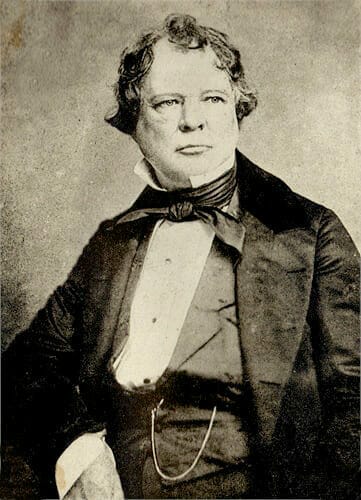William Gilmore Simms
 William Gilmore Simms
Although not an Alabamian himself, William Gilmore Simms (1806-1870), the leading author of the antebellum South, chose the state as the setting for two novels and one short story. In all, Simms wrote more than a dozen novels, three books of poetry, and a history of South Carolina. In 1842, he was awarded an honorary LL.D. degree from the University of Alabama, addressing the Erosophic Society on “The Social Principle: The True Source of National Permanence.” Simms also helped Albert James Pickett write his History of Alabama (1851).
William Gilmore Simms
Although not an Alabamian himself, William Gilmore Simms (1806-1870), the leading author of the antebellum South, chose the state as the setting for two novels and one short story. In all, Simms wrote more than a dozen novels, three books of poetry, and a history of South Carolina. In 1842, he was awarded an honorary LL.D. degree from the University of Alabama, addressing the Erosophic Society on “The Social Principle: The True Source of National Permanence.” Simms also helped Albert James Pickett write his History of Alabama (1851).
Simms was born on April 17, 1806, in Charleston, South Carolina. He attained national fame as the author of The Yemassee (1835), his popular romance of the Native American group’s defeat in South Carolina in the Yamasee War of 1715-17. When the sectional crisis over secession erupted in the late 1840s, Simms used the American Revolution in novels to promote the secessionist cause as a second revolution.
Simms’s most interesting picture of frontier Alabama comes in Richard Hurdis: A Tale of Alabama (1838), which presents his model for western settlement. In it, he advocates social ties and a stable home as ways to overcome the ills of nomadism and crime. Richard Hurdis, the son of a planter in Marengo County, visits the peaceful country home of Colonel Grafton near Tuscaloosa. Based on the real-life events surrounding John A. Murrell’s gang, Colonel Grafton and Hurdis enlist the upright members of the community to defeat the plots of an outlaw gang. The outlaws are captured and lynched, representing Simms’s approval of frontier justice when law and order are threatened.
Simms adds another romanticized picture of frontier Alabama in “The Snake of the Cabin,” one of the most notable tales in his collection The Wigwam and the Cabin (1845), in which an evil northerner commits bigamy and tries to steal enslaved people, only to be foiled by a loyal slave, a character common in the pro-slavery literature popular at this time. Simms again showed his strong interest in an idealized version of Alabama’s history in Vasconselos: A Romance of the New World (1854), which tells the story of Hernando de Soto’s passage. In it, Vasconselos, a fictional character based on a Portuguese member of the expedition, is enraged at de Soto’s treatment of the Indians and joins Mississippian chief Tuskaloosa in fighting the Spaniards at the Battle of Mabila.
Simms died on June 11, 1870, in Charleston, South Carolina, and was buried in the city’s Magnolia Cemetery.
Selected Works by William Gilmore Simms
“The Social Principle: The True Source of National Permanence” (1843)
Vasconselos: A Romance of the New World (1853)
Woodcraft, or Hawks About the Dovecote: A Story of the South at the Close of the Revolution (1854)
Richard Hurdis: A Tale of Alabama (1855)
The Wigwam and the Cabin (1856)
Additional Resources
Guilds, John Caldwell. Simms: A Literary Life. Fayetteville: University of Arkansas Press, 1992.
“DeSoto’s Expediton: Contrasting Treatments in Pickett’s History of Alabama and Simms’s Vasconselos.” Alabama Review 31 (July 1978): 199-208.
Watson, Charles S. From Nationalism to Secessionism: The Changing Fiction of William Simms. Westport, Conn.: Greenwood Press, 1993.
Wimsatt, Mary Ann. The Major Fiction of William Gilmore Simms: Cultural Traditions and Literary Form. Baton Rouge: Louisiana State University Press, 1989.



